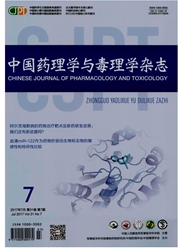

 中文摘要:
中文摘要:
目的体外建立艾洛替尼(erlotinib)耐药的人肝癌细胞系HepG2/erlotinib,鉴定其生物学特性,并对其耐药机制进行初步探讨。方法逐步递增艾洛替尼并最终给予艾洛替尼50μmol·L-1连续冲击HepG2细胞12个月,建立HepG2/erlotinib。磺酰罗丹明B法检测HepG2/erlotinib耐药倍数和耐药谱;测定细胞生长曲线并计算细胞增殖时间;流式细胞术检测细胞周期;RT-PCR和Western印迹法检测HepG2/erlotinib细胞乳腺癌耐药蛋白(BCRP)基因和蛋白的表达;流式细胞术检测细胞表面BCRP蛋白表达。结果经过12个月艾洛替尼诱导的HepG2耐药细胞,艾洛替尼的IC50值为(72.3±6.1)μmol·L-1,艾洛替尼对正常HepG2细胞的IC50值为(10.6±0.3)μmol·L-1,耐药倍数为6.84±0.7,表明HepG2/erlotinib为艾洛替尼耐药细胞系。HepG2/erlotinib对顺铂、多柔比星、米托蒽醌和拓扑替康的IC50均大于正常HepG2细胞的IC50,表明产生交叉耐药性。HepG2细胞和HepG2/erlotinib细胞的群体倍增时间分别为(20.7±3.3)h和(26.74±1.2)h,耐药细胞倍增时间延长。与HepG2细胞相比,HepG2/erlotinib的S期细胞比例明显增高(P〈0.05),G0/G1期细胞比例明显降低(P〈0.01);HepG2/erlotinib细胞中BCRP基因和BCRP蛋白表达显著升高(P〈0.05)。结论建立的HepG2/erlotinib具有耐药细胞的特征和生物学特性,其耐药机制与BCRP蛋白表达增加有关。
 英文摘要:
英文摘要:
OBJECTIVE To establish a human hepatocellular carcinoma cell line with resist- ance to erlotinib, and to investigate its possible resistance mechanism. METHODS The cell line HepG2 was cultured by gradually increasing dose of erlotinib and final dose 50 μmol·L- 1 in vitro for 12 months to generate its resistance cell line HepG2/erlotinib. The resistant index of ertotinib was determined by sulforhodamine B (SRB) ; cell growth curve, doubling time and cell cycle phase dis- tribution were measured; breast cancer resistance protein (BCRP) mRNA and its protein level were examined by RT-PCR, Western blotting and flow eytometry . RESULTS After induced for 12 months, a resistant cell line HepG2/erlotinib was established. The IC50 value of HepG2/erlotinib to erlotinib was (72.3 ± 6.1 )μmol ·L-1 while that of HepG2 to erlotinib was (10.6±0.3 )μmol· L-1, with the resistant index of 6.84 ± 0.7. The ICs0 values of HepG2/erlotinib to cisplatin, doxorubi- cin, mitoxantrone and topotecan were greater than that of HepG2 cells, indicated that it had cross resistance to these drugs. The doubling time of HepG2 and HepG2/erlotinib was ( 20.7 ± 3.3 ) h and (26.7 ± 1.2) h, respectively. In the HepG2/erlotinib resistant cell line, the cell numbers of S phase increased (P 〈 0.05 ) while that of G0/G1 phase decreased ( P 〈 0.01 ). HepG2/erlotinib cells expressed higher levels of BCRP mRNA and BCRP protein compared with parental cells ( P 〈 0.05 ). CONCLUSION erlotinib is established. It high BCRP expression may An erlotinib-resistant human hepatocellular carcinoma cell line HepG2/ shows a typical resistant phenotype and biological characteristics. The contribute to its resistance to erlotinib.
 同期刊论文项目
同期刊论文项目
 同项目期刊论文
同项目期刊论文
 Synthesis and biological evaluation of bifendate-chalcone hybrids as a new class of potential P-glyc
Synthesis and biological evaluation of bifendate-chalcone hybrids as a new class of potential P-glyc Bifendate-chalcone hybrids: A new class of potential dual inhibitors of P-glycoprotein and breast ca
Bifendate-chalcone hybrids: A new class of potential dual inhibitors of P-glycoprotein and breast ca Synthesis and evaluation of substituted dibenzo[c,e]azepine-5-ones as P-glycoprotein-mediated multid
Synthesis and evaluation of substituted dibenzo[c,e]azepine-5-ones as P-glycoprotein-mediated multid IGF-1R and ErbB3/HER3 Contribute to Enhanced Proliferation and Carcinogenesis in Trastuzumab-resista
IGF-1R and ErbB3/HER3 Contribute to Enhanced Proliferation and Carcinogenesis in Trastuzumab-resista Anticancer efficacy of a nitric oxide-modified derivative of bifendate against multidrug-resistant c
Anticancer efficacy of a nitric oxide-modified derivative of bifendate against multidrug-resistant c Anti-IGF-1R monoclonal antibody inhibits the carcinogenicity activity of acquired trastuzumab-resist
Anti-IGF-1R monoclonal antibody inhibits the carcinogenicity activity of acquired trastuzumab-resist Discovery of alkoxyl biphenyl derivatives bearing dibenzo[c,e]azepine scaffold as potential dual inh
Discovery of alkoxyl biphenyl derivatives bearing dibenzo[c,e]azepine scaffold as potential dual inh Synthesis and evaluation of nitric oxide-releasing DDB derivatives as potential Pgp-mediated MDR rev
Synthesis and evaluation of nitric oxide-releasing DDB derivatives as potential Pgp-mediated MDR rev 期刊信息
期刊信息
